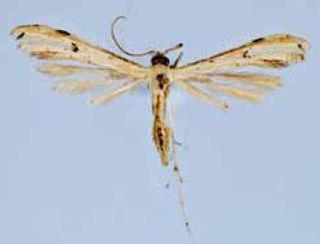Dombeya amaniensis is a flowering plant species found only in Tanzania. Formerly placed in the family Sterculiaceae, this artificial assemblage is now included in the Malvaceae by most authors.

Tiliacea citrago, the orange sallow, is a species of moth of the family Noctuidae. It is found in Europe as far east as the Caucasus Mountains and the Urals.

The Barred Sallow(Tiliacea aurago) is a moth of the family Noctuidae. It is found in Europe.
Tiliacea is a genus of moths of the family Noctuidae.

Encoelia is a genus of fungi in the family Sclerotiniaceae.

Parmelina is a genus of lichen belonging to the family Parmeliaceae. The genus was circumscribed in 1974 by American lichenologist Mason Hale with Parmelina tiliacea assigned as the type species.

Xestia ochreago is a moth of the family Noctuidae.

Hellinsia devriesi is a moth of the family Pterophoridae. It is found on the Galapagos Islands and Guadeloupe.

Adaina ipomoeae is a moth of the family Pterophoridae. It is found in Cuba, Jamaica, Puerto Rico, Guadeloupe, the Dominican Republic, Grenada, and Florida.

Xanthoparmelia tinctina is a species of lichen from the family Parmeliaceae that can be found in Arizona, California, Northern Africa and Europe. The upper surface is yellow–green, while the bottom surface is brown and flat, measuring 0.2–0.6 millimetres (0.0079–0.0236 in) in diameter. The apothecia are 2–10 millimetres (0.08–0.39 in) wide, the thallus is laminal and is 3–10 centimetres (1–4 in) in diameter. The disc is either cinnamon-brown or dark brown and is ellipsoided. The pycnidia are immersed, and the conidia are bifusiform, with 8-spored asci that are hyaline and ellipsoid.

Gripsholms hjorthage is a deer park and nature reserve close to Gripsholm Castle in Södermanland County, Sweden. The deer pasture is dominated by many old oak trees. The area has been used for grazing for a long time, and as a deer park since the end of the 19th century. It was declared a nature reserve in 2001 after the discovery of the red-listed hermit beetle in the area. It is also popular as a recreational area.
Austroparmelina is a genus of foliose lichens in the large family Parmeliaceae. It contains species formerly placed in the genera Parmelina and Canoparmelia. All species of Austroparmelina have an Australasian-South African distribution.
Bulbothrix meizospora is a species of foliose lichen in the family Parmeliaceae. It is found in Africa, Asia, and South America, where it grows on tree bark.
Xanthoparmelia elixii is a lichen in the family Parmeliaceae, and found in South Australia.
Tiliacea sulphurago is a species of moth belonging to the family Noctuidae.
Paracephaelis is a genus of flowering plants belonging to the family Rubiaceae.
Sclerococcum serusiauxii is a species of lichenicolous fungus in the family Dactylosporaceae. It was described as a new species in 1993 by Montserrat Boqueras and Paul Diederich. The type was collected in Col de la Pierre St Martin, at an altitude of 1,550 m (5,090 ft). Here, the fungus was growing on the lichen Parmelina pastillifera, which itself was growing on Pinus uncinata. The specific epithet honours Belgian lichenologist Emmanuël Sérusiaux, who collected the type specimen in 1989. S. serusiauxii has also been recorded from Montenegro.

Parmelina quercina is a species of foliose lichen in the large family Parmeliaceae. It is found in continental Europe.










